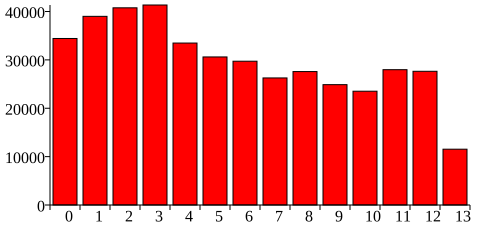A quick post because I had the data in front of me: some statistics about countries. In a recent blog post on the Discogs blog it said "Many of the release countries expanding the fastest in the database are from Central America, South America, and Southeast Asia."
As I am already keeping some of that data it is easy to just plot a few simple graphs of some countries using the data from March 31 2019 and see if this is true (spoiler: maybe not).
Clearly it seems that many releases from Germany were added in the early days and then fewer and fewer were added.
There are far fewer releases from Spain than from Germany in the database, and the peak is later (because the Spanish collectors only started to show up later?, but there is still a drop.
The graph is similar to the one from Germany, but smaller. Quite a few early contributors were from the Netherlands, so it is not entirely unexpected.
Not unlike Spain, but Italian releases started to be added a bit earlier. Perhaps it is because of Italian house and Discogs being mostly dance oriented in the beginning?
Interestingly, there is a sharp increase first, and then it falls again.
No arguing with that!
Although not yet at the same level as Brazil it is coming at full speed.
Bolivia is very sparsely populated, so probably not many releases, but still growth.
Similar to Bolivia, but it would be interesting to know why fewer releases from Peru were added for a while!
For releases from Thailand there is first a sharp increase, but then it is pretty constant. I wonder why. Perhaps there is not a big market for Thai records, or there only a few very active contributors from Thailand on Discogs (and they have limited time)?
Now, that is a bit unexpected! As it turns out the biggest increase for the countries (where I am treating "unknown" as a country as well) is actually the releases with no known country! But why is that? Laziness? New releases that are "worldwide" releases? Older releases having been fixed more thoroughly? So many questions...
As I am already keeping some of that data it is easy to just plot a few simple graphs of some countries using the data from March 31 2019 and see if this is true (spoiler: maybe not).
Germany
Let's look at German releases first (note: this does not mean releases of German artists, or releases in German, but releases from Germany). |
| Releases from Germany |
Spain
Then Spain, which I feel probably still has many releases missing (although there seems to be a very active Spanish community on Discogs). |
| Releases from Spain |
There are far fewer releases from Spain than from Germany in the database, and the peak is later (because the Spanish collectors only started to show up later?, but there is still a drop.
The Netherlands
 |
| Releases from The Netherlands |
Italy
 |
| Releases from Italy |
Not unlike Spain, but Italian releases started to be added a bit earlier. Perhaps it is because of Italian house and Discogs being mostly dance oriented in the beginning?
France
France is quite interesting because the number of releases from France being added has been pretty constant over the years: |
| Releases from France |
Greece
 |
| Releases from Greece |
Brazil
Now let's look at some of the countries where Discogs report explosive growth, starting with Brazil: |
| Releases from Brazil |
India
 |
| Releases from India |
Bolivia
 |
| Releases from Bolivia |
Bolivia is very sparsely populated, so probably not many releases, but still growth.
Peru
 |
| Releases from Peru |
Thailand
 |
| Releases from Thailand |
Unknown
And finally, releases for which no country was specified: |
| Releases for which country is known |
Comments
Post a Comment